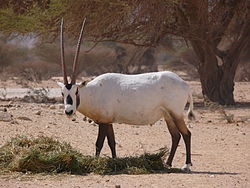
Arabian Oryx
Oryx leucoryx
About Arabian Oryx
The Arabian oryx or white oryx is a medium sized antelope with a distinct shoulder hump, long straight horns, and a tufted tail. It is a bovid, and the smallest member of Oryx genus, native to desert and steppe areas of the Arabian peninsula. The Arabian Oryx was extinct in the wild by the early 1970s, but was saved in zoos and private preserves and reintroduced into the wild starting in 1980.
Historically the Arabian oryx probably ranged throughout most of the Middle East. In the early 1800s they could still be found in the Sinai, Israel, the Transjordan, much of Iraq, and most of the Arabian peninsula. During the 19th and early 20th centuries, the range of the Arabian Oryx was pushed back towards Saudi Arabia, and by 1914 there were only a few survivors outside that country. There were a few reports of Arabian Oryx in Jordan into the 1930s, but by the mid 1930s the only remaining populations were in the Nafud Desert in the Northwest of Saudi Arabia and the Rub' al Khali in the South.
In the 1930s, Arabian princes and oil company clerks started hunting Arabian oryx with automobiles and rifles. Hunts grew in size, and some were reported to employ as many as 300 vehicles. By the middle of the twentieth century, the Northern population was effectively extinct. The last Arabian Oryx in the wild prior to reintroduction were reported in 1972.
Arabian oryx prefer to range in gravel desert or hard sand where the speed and endurance will protect them from most predators, as well as most hunters on foot. In the sand deserts in Saudi Arabia, the Arabian oryx used to be found in the hard sand areas of the flats between the softer dunes and ridges.
Arabian oryx have been reintroduced to Oman, Saudi Arabia, Israel, United Arab Emirates, and Jordan. There is a small introduced population on Hawar Island, Bahrain and large semi-managed populations at several sites in Qatar and UAE. The total reintroduced population is now estimated to be around 1,000. This puts the Arabian oryx well over the threshold of 250 mature individuals needed to qualify for Endangered.
